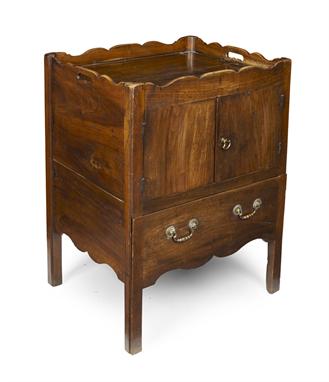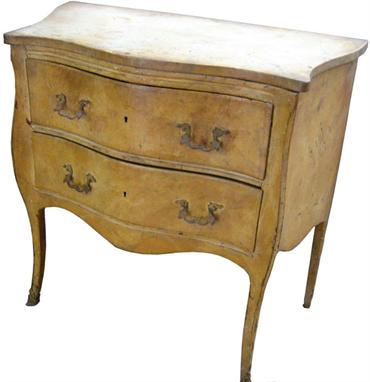We found 19970 price guide item(s) matching your search
There are 19970 lots that match your search criteria. Subscribe now to get instant access to the full price guide service.
Click here to subscribe- List
- Grid
-
19970 item(s)/page
An Italian painted and parcel gilt commode, late 18th century, the top with outbreak corners and carved moulded edge, the centre of the top painted with a cartouche depicting a mythological scene, swags and an urn and flowers, with green painted border, above a long drawer above three long drawers each modelled as two short drawers, the canted corners painted with Classical motifs, on a a plinth base, 98cm high, 150cm wide, 69cm deep
A French amaranth, specimen wood marquetry and gilt metal mounted commode, stamped with the crowned coat of arms of Amsterdam and J.G for the St Joseph Guild, circa 1775, the grey marble top with moulded edge, above two long drawers, the marquetry depicting a basket of flowers, the canted sides with fluted marquetry and git metal mounts, on gilt metal mouted slender cabriole legs terminating in sabots, 82cm high, 98cm wide, 45cm deep. See Sotheby’s New York, Important French Furniture, 23 Nov 09, Lot 83 for a Louis XV/Louis XVI ormolu-mounted tulipwood, amaranth, parquetry and marquetry table de toilette bearing the same stamp and with the following literature. ‘In recent years it has become apparent that in both Amsterdam and The Hague and almost certainly in other large Dutch cities as well, marquetry furniture in the French manner was produced from the 1760s onwards. The Dutch furniture makers who first began to work in the French manner were not introducing a taste previously unknown in the Netherlands; on the contrary, they tried to imitate furniture from France because it was being imported in large amounts and found high favour with the buying public. Both the city of Amsterdam and of The Hague the furniture makers’ guild complained to the local government of this practice of importing and selling furniture, which was officially forbidden. In 1770 the Amsterdam city council received a request from the Amsterdam Guild of Saint Joseph in which a complaint was made about the importation of furniture and that this foreign competition had forced many furniture makers to reduce the size of their workshops. As a result, the Amsterdam city council renewed and amplified the ban on importing foreign furniture in January 1771. In order not to harm the interests of tradesman and the (foreign) stock they still had in stock, the trade was allowed to sell these last pieces, provided they were stamped with the mark of the Guild of Saint Joseph. This is the stamp composed of the letters J and G flanking the crowned coat-of-arms, which occurs either raised within a sunken reserve or directly impressed in the wood.’ See Baarsen, R.J., Aspecten van de Nederlandse meubelkunst in de tweede helft van de achttiende eeuw, Alphen aan den Rijn, 1993, pp. 157, 158, 168 (Reinier Baarsen, French Furniture in Amsterdam in 1771, Furniture History Society Journal, 1993, p. 114-127). For a similar commode also bearing the stamp for The St Joseph Guild, see Christie’s Interiors, Style & Spirit, 12 May 2009 London, South Kensington, Lot 565.
CHARLES II WALNUT AND UPHOLSTERED STOOL LATE 17TH CENTURY the padded seat raised on baluster turned legs united by a peripheral stretcher; together with a George III mahogany commode, raised on square chamfered legs; and a George III oak tripod table, reduced in height (3) 43cm wide, 42cm high, 36cm wide; commode, 44cm wide, 50cm high
A Victorian mahogany and painted commode in the Adam taste by Edwards & Roberts of London, the grey/rosso marble top above a single frieze drawer, bearing maker`s stamp "Edwards & Roberts" over two cupboard doors enclosing a single shelf raised on square tapered supports, 104 cm wide (ILLUSTRATED)
-
19970 item(s)/page















































